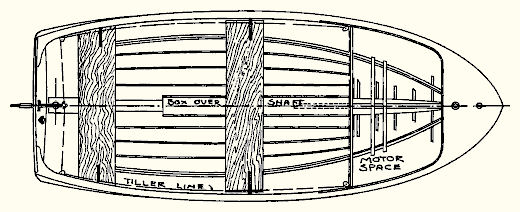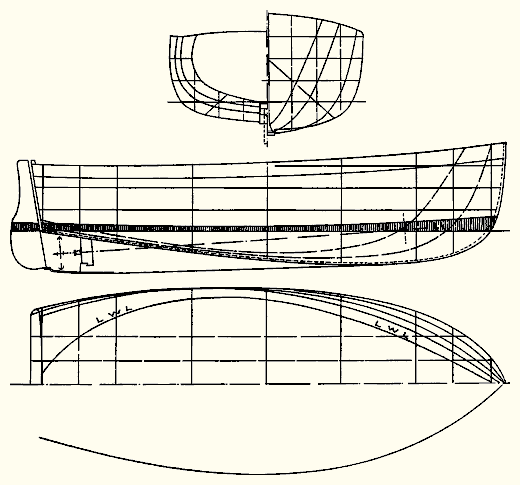

A dinghy much under 10 feet in length begins to encroach on the side of the Lilliputs; fine for little people, if not too many, and fine for rowing. Any boat under 10 feet in length is a better boat without inboard power. Inboard power makes a motor boat of the little packet, and a motor boat requires freeboard, and flare, and a proper bottom, and depth. The production of tiny light-weight air-cooled and water-cooled single cylinder marine motors like the Lauson, Briggs & Stratton, Wisconsin, Buda, etc., etc. have brought into the field excellent power plants for power dinghies and small craft of varied other kinds. These motors are ample in power, reliable, and light in weight, and inexpensive. Being unit power plants with fuel tank, reduction gear, muffler, and all equipment attached these motors are easy to install, and simple to service. Tinkle Bell is designed around one of these motors.

The little boat is 10 feet 7 inches in over all length; 4 feet 4 inches in breadth; 11 inches draft (with load) ; the freeboard at the bow is 2 feet, and at the stern, 1 foot 6 1/2 inches. There is lots of depth to the hull. In a boat like this Tinkle Bell one has the comfortable feeling of sitting down in the boat, rather than sitting on the boat. And, let me remark, there is a great difference between the two feelings. Sitting on either middle or after seats, armpits come slightly above the edge of the deck in this 10 foot 7 inch long motor dinghy.

The arrangement of the deck and cockpit is unusual for a dinghy. It will be noticed that there is a bulkhead pretty well forward. There is a short forward deck, which fades away into the covering boards leading aft each side. Between the bulkhead and the deck there is a well in which to install the motor. The bulkhead will be made from 1/4-inch thick mahogany Weldwood or some other water-proof light-weight plywood. The bulkhead should be, rather must be, fitted with a louvered panel permitting air to flow away from the air-cooled cylinder. If a water-cooled motor is used the ventilating panel can be omitted. The coaming is raised above the level of the deck only from a point 8 inches abaft the bulkhead thence along the sides and across the after end of the forward deck. The coaming should raise above the deck not much over 1 1/2 inches, tapering a bit aft to add finesse. Everything belonging to the motor will go forward of the bulkhead. The exhaust pipe may be run directly out the side at the motor; or led through a copper tube, thence out the stern. The pipe will be hot. Cover it with a light metal shield made. from very thin copper sheet. The shield need be only on the exposed side of the exhaust pipe.
Provide also a small spray hood made to cover the motor well. This hood can be supported on a light ridge pole reaching from bulkhead to forward deck�not too high and with the after end open to permit circulation. The hood will attach to the outside of the coamings with good automobile side curtain fasteners. With this hood, spray and rain will be kept away from the intake of the carbureter and the ignition parts. All of which work better if kept in a dry and warm place.

The form of the hull, naturally, determines somewhat the way the boat is to be put together. And so it may not be amiss to point out the general characteristics of the form. The model is of round bilge with rather flat sections. The turn at the bilge is hard and will therefore give a lot of initial stability. The topsides aft show moderate tumble home. The forward sections above water have good flare but not flam, flam being the reverse curve as the section lines approach the edge of the deck. The deepest part of the hull is between stations 2 and 4, and it will be remarked that the center of bouyancy is pretty well forward. The buttock lines are flat abaft station 6; but the sections show generous deadrise. The bottom has skeg for full length to give longitudinal strength to the bottom, and to afford protection to the propeller and rudder. A little boat like this has often to run on the beach and with this in view the straight deep skeg will be a welcome feature. The deck line is bluff forward. While this is a difficult form to build, the great buoyancy and flare the bluffness gives the topsides should be more than worth the additional labor of building it so.